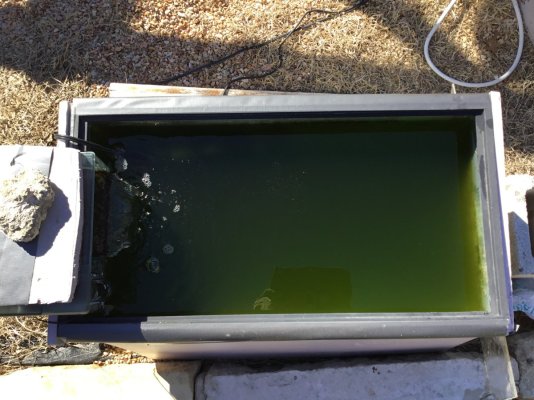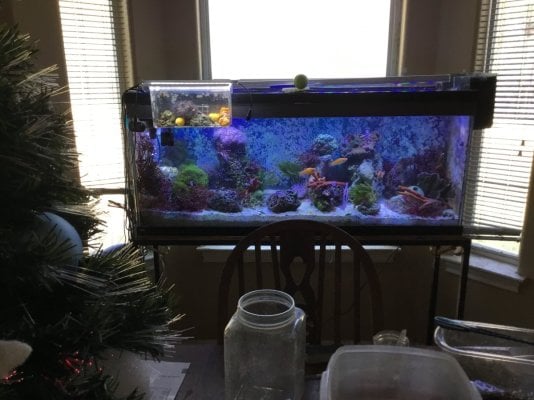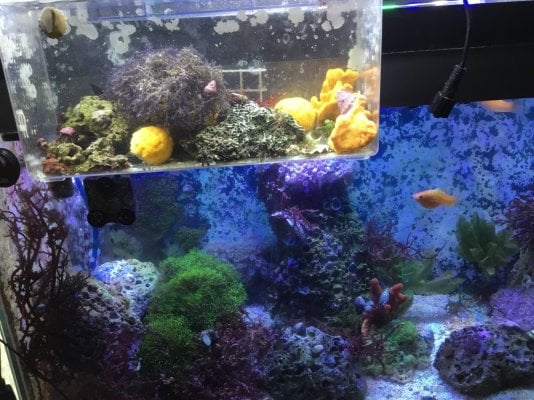Navigation
Install the app
How to install the app on iOS
Follow along with the video below to see how to install our site as a web app on your home screen.
Note: This feature may not be available in some browsers.
More options
You are using an out of date browser. It may not display this or other websites correctly.
You should upgrade or use an alternative browser.
You should upgrade or use an alternative browser.
Hello from an invertebrate enthusiast!
- Thread starter PoetaCorvi
- Start date
- Tagged users None
kevgib67
10K Club member
View Badges
Hospitality Award
Midwest Reefer
Rock Pool Reef Keepers
Ohio Reefer
My Tank Thread
My Aquarium Showcase
Welcome, glad you are here! So many choices, I look forward to seeing the direction you choose!
1112-425XL
2500 Club Member
View Badges
Partner Member 2024
Tampa Bay Reef Keepers
Hospitality Award
MAC of SW Florida
Rock Pool Reef Keepers
My Tank Thread
My Aquarium Showcase
The goal with the plankton is unsanitized wild cultures, with emphasis on zooplankton! Not as interested in studying phytoplankton atm, though I’m sure there will be some in the plankton tow. I don’t want to study any plankton species in particular, instead I’m looking to observe the biodiversity and dynamics between different species of wild marine plankton (including fauna like parasites and ‘pests’).kudos to your first post & vision:
With respect to phytoplankton culture with your invert tank, if your inverts were filter feeders then dosing phytoplanjton would be good. If you want specific sustainable phyto to study, you require culture equipment to be sanitized. Many reputable online vendors.
Aim for the Stars, Keep your feet on the ground.
“My first project will hopefully be an ecosphere/pico tank comprised of plankton collected from the atlantic! I’ve badly wanted to observe marine plankton up close, since it gives access to a huge range of biodiversity in a single container. I figured instead of buying plankton to observe and then just.. letting it die, I could set up a small marine tank and see if I can sustain a miniature ecosystem.“
I wouldn’t start with a stocked invert tank. Instead the idea is that the invertebrates would come from larval plankton establishing itself in the enclosure, so I will not be adding any hand picked invertebrates to the ecosphere! The inhabitants of the ecosphere will be decided by whichever species thrive most.
Welcome! A suggestion for you regarding lighting. I started in reefing with a Fluval Marine led light, and while I’ve graduated to more powerful lights that are better for growing coral, that Fluval was a beautiful, soft, clear light with a big variety of colors. And most importantly, it is based on lower powered leds that can be set very low and moody, much more so than a typical coral grow light.
Since many inverts are more active towards night, this particular light would be a great match and let you really showcase some cool biomes or times of day at light settings that encourage natural behavior.
Since many inverts are more active towards night, this particular light would be a great match and let you really showcase some cool biomes or times of day at light settings that encourage natural behavior.
Welcome! I look forward to see what you’re up toHello!
I’ve had a fascination with marine invertebrates for a while now. I have decent experience keeping terrestrial inverts (mostly arthropods), but have yet to venture into aquatics. I had a lot of people tell me I needed to master freshwater first, but I’m not very interested in freshwater and it kinda kept me from entering the hobby. Then I realized they were usually talking about marine fish, not marine invertebrates. I don’t see myself keeping marine fish in the near future, but I’m eager to learn more about creating marine invertebrate setups!
I’m particularly interested in crustaceans, which already make up most of my terrestrial inverts (isopods lol)!
My first project will hopefully be an ecosphere/pico tank comprised of plankton collected from the atlantic! I’ve badly wanted to observe marine plankton up close, since it gives access to a huge range of biodiversity in a single container. I figured instead of buying plankton to observe and then just.. letting it die, I could set up a small marine tank and see if I can sustain a miniature ecosystem.
I also have an empty 40 gallon breeder. It was originally for a large group of desert beetles, but that project ended a while ago and now it’s just been sitting there for a few months. I’ve pondered on a lot of ideas, but still not sure what I want to do yet haha.
I hadn’t considered putting one in the 40b since I’d wanted to use it for a community tank, but learning how crafty they are I’m a lot more tempted. I’ve only done surface level research on keeping them, and the tanks I’ve seen so far just keep them in PVC pipes, it’s a shame. Gave me the impression that they were less active and just dwelled in hides until food time, so I didn’t think they’d make use of a whole 40b. Not fully set on what I wanna do, but peacock mantis is definitely on the list of ideas now!I kept one full lifespan in a 28g glass nano cube. I wouldn’t put in cheap thin glass 5g tank lol but a 40b would be good. They really don’t strike the glass unless you encourage it. They are builders and want to smash rock or shells
Awesome, thank you!! Will definitely look into getting those for my inverts, they sound perfect.Welcome! A suggestion for you regarding lighting. I started in reefing with a Fluval Marine led light, and while I’ve graduated to more powerful lights that are better for growing coral, that Fluval was a beautiful, soft, clear light with a big variety of colors. And most importantly, it is based on lower powered leds that can be set very low and moody, much more so than a typical coral grow light.
Since many inverts are more active towards night, this particular light would be a great match and let you really showcase some cool biomes or times of day at light settings that encourage natural behavior.
Are you a microbiologist in academia?The goal with the plankton is unsanitized wild cultures, with emphasis on zooplankton! Not as interested in studying phytoplankton atm, though I’m sure there will be some in the plankton tow. I don’t want to study any plankton species in particular, instead I’m looking to observe the biodiversity and dynamics between different species of wild marine plankton (including fauna like parasites and ‘pests’).
I wouldn’t start with a stocked invert tank. Instead the idea is that the invertebrates would come from larval plankton establishing itself in the enclosure, so I will not be adding any hand picked invertebrates to the ecosphere! The inhabitants of the ecosphere will be decided by whichever species thrive most.
I have wild phyto in my back yard. Where do you live?The goal with the plankton is unsanitized wild cultures, with emphasis on zooplankton! Not as interested in studying phytoplankton atm, though I’m sure there will be some in the plankton tow. I don’t want to study any plankton species in particular, instead I’m looking to observe the biodiversity and dynamics between different species of wild marine plankton (including fauna like parasites and ‘pests’).
I wouldn’t start with a stocked invert tank. Instead the idea is that the invertebrates would come from larval plankton establishing itself in the enclosure, so I will not be adding any hand picked invertebrates to the ecosphere! The inhabitants of the ecosphere will be decided by whichever species thrive most.

Nope! I’m passionate about arthropodology and hope to formally study it, I am currently 19 so haven’t really had the time to get there yet haha. My interest in the plankton is mostly because of the invertebrates!Are you a microbiologist in academia?
Grow in seperate systems. It will save on headaches.Nope! I’m passionate about arthropodology and hope to formally study it, I am currently 19 so haven’t really had the time to get there yet haha. My interest in the plankton is mostly because of the invertebrates!
I appreciate it! But I am looking for plankton tows in open ocean that includes high zooplankton diversity (zooplankton being animals like larval crustaceans, copepods, larval anemones, so on), and already have a source
Interesting.
Mid Atlantic phyto blooms from Sahara Desert dust sparked phyto bloom seen from space. Detailed analysis of phytoplankton strain showed to have gone extinct 100 million years ago, when the Safari was a shallow ocean.
Mid Atlantic phyto blooms from Sahara Desert dust sparked phyto bloom seen from space. Detailed analysis of phytoplankton strain showed to have gone extinct 100 million years ago, when the Safari was a shallow ocean.
Nothing in particular! For my terrestrial species I mostly keep peaceful detritivores/omnivores, though I’ve kept mantises and other odd predatory inverts. Less about preferring peaceful inverts, and more about liking the care routines for them. I am very interested in community tanks, the great thing about inverts is you can create a small ecosystem that includes aggressive and peaceful species, if you are knowledgeable enough. Though not true for all inverts of course, I don’t imagine I’d have much luck putting a mantis shrimp in a community tank lol.Inverts are amazing.you going for Peaceful or aggressive species ?
I’m not sure what you mean by this, could you explain?Grow in seperate systems. It will save on headaches.
That’s fascinating!Interesting.
Mid Atlantic phyto blooms from Sahara Desert dust sparked phyto bloom seen from space. Detailed analysis of phytoplankton strain showed to have gone extinct 100 million years ago, when the Safari was a shallow ocean.
Dose phytopkankton to inverts. This is my community tank: heavy on sponges, flame scallops, and to your favorite coral banded shrimp and many hermits & emerald crabs. Unless you are food, these janitors play nice.I’m not sure what you mean by this, could you explain?
Grow phyto in seperate culture.




Last edited:
The idea with the pico tank is being mostly hands off and allowing an ecosystem to form! So I would not be adding food to it, it would sustain itself ideally. This is a reddit dedicated to this type of project! https://www.reddit.com/r/Seacospheres/s/TZOXmLNFQY
I don’t plan on creating a sealed ecosphere like some of these, would be using a small filter and air pump, but otherwise the same concept.
Similar threads
- Replies
- 3
- Views
- 120



















